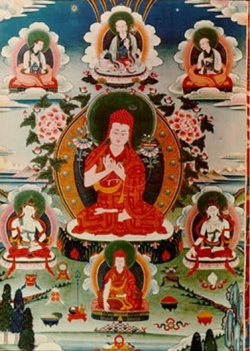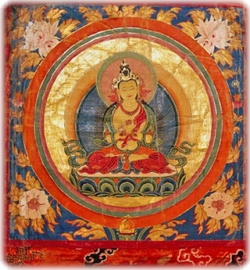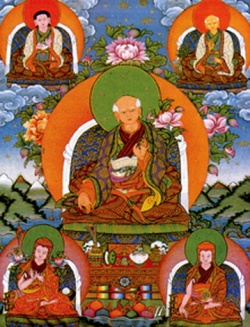The Lam Dre Teachings: A Brief History
The Sakya order is the second oldest of the four principal traditions of Tibetan Buddhism. At its heart is the lineal transmission of Lam Dre ("The Path and Its Result"), a system of knowledge of practicing the entire range of sutric and tantric teachings of the Buddha that was first enunciated by the 9th-century Indian tantric master and saint Mahasiddha Virupa, and was brought to Tibet from India by Gayadhara and Drogmi Shakya Yeshe the translator (990-1074).
In the beginning of the second phase of Buddhism in Tibet (953), following Lang Dharma's near-destruction of the faith, there was a period of intense and active interchange between Indian and Tibetan spiritual centers. Lha Lama Yeshe Ö, a Ngari king, sent twenty-one young Tibetans to study sutras, tantras, logic, language, and medicine in Kashmir , India . Among them were Lochen Rinchen Sangpo (958-1055), the great monk who pioneered the second-phase translation, and Ngog Legpei Sherab. At the behest of Yeshe Ö's nephew Jangchub Ö, Nagtso Lotsawa then invited Dipamkara Shrijñana Atisha to come to Tibet from Vikramashila Monastery, the major center of Buddhist learning in India . Ngog's young nephew Loden Sherab, one of the translators of thousands of scriptures into Tibetan, also made a journey to study in India where he found himself accompanied by four other major pioneers of transmission, Lotsawa Tsen Khawoche, Khyungpo Chötson, Ra Lotsawa, and Nyen Lotsawa.
It was during this great spiritual revival, inspired by the teachers of that time and need for the further introduction of Buddhism into Tibet, that the great Drogmi Shakya Yeshe, accompanied by Taglo Zhonnu Tsöndru and Leng Yeshe Zhönnu, set out to India through Nepal on a momentous journey that would end in the dissemination of the Lam Dre in Tibet. They studied Hevajra, Samvara, Guhaysamaja, Yamantaka, and Mahamaya tantras for a year under Shanta Bhadra in Nepal . Escorted by their teacher's brother, Mahapandita Abhayakirti, they traveled to Vikramashila Monastery, with a stopover in Bodhgaya for their initial prayer and salutations to the Mahabodhi shrine.
For eighteen years, Drogmi studied monastic disciplines, Prajñanaparamita, and Samvara and Hevajra tantras from Shantipa. Drogmi mastered the root, narrative, instructive, and the supplemental fragmental tantras. Among his other teachers were Vagendra Kirti, Prajñakara Gupta, Narotapa, Jñanashri, and Ratnavajra. When the great Master Viravajra realized that Drogmi was a most able and worthy student he introduced Drogmi to the teachings of the great 9th-century adept Virupa. The entire instruction on Triple Tantra of Hevajra Root, along with its exegesis, was given. When the time finally approached for Drogmi's return to Tibet , his master instructed him in about eighty major tantras along with exegetical commentaries, numerous meditative manuals with their rites, and about fifty dharanis in connection with sutras. As a going-away dharma-gift Drogmi received a Lam Dre teaching (without the root text), its auxiliary instructions, and profound teachings on the transference of consciousness. "Rejoice, for I have successfully transmitted all the teachings I have to give. Now go to Tibet and integrate your practice and teaching. I will come sometime to help clear up your doubts. Since you are the holder of the teachings of the Yogeshwara (Virupa), there will come a master who will bring the entire teaching to your doorstep." With these words from Viravajra, Drogmi Lotsawa left India for the last time.
Drogmi's return to Tibet and his teachings inspired numerous scholars and saints, among whom were the Great Marpa Lotsawa and Gö Khugpa Letse. A monastic university was established in Mukhulung in Mangkhar, and students poured in from upper, central, and eastern Tibet . As Drogmi's teacher Viravajra had prophesied, early one morning the sound of a ram's horn was heard at the great master's residence in Mukhulung, proclaiming the arrival of a pandita or Indian master. Pandit Gayadhara was on his way to Purang. He and Drogmi proposed a rendezvous some time in the coming two or three years, when Gayadhara would accomplish his "visit to Purang and chores in Nepal ." After two years, two messengers arrived with news of Gayadhara's arrival. The entire Lam Dre was taught, including the root verses, for a period of three years. The initiations, instructions, and commentaries of the Triple Tantras were simultaneously translated. Mukhulung was thus firmly established as the seat of Lam Dre teachings and practices. Before Gayadhara left, he prophesied Drogmi as the one who "will traverse the divine realm of Khechara within this very life without having to leave his body behind."
Although tantric and sutric teachings were well established in Tibet before Drogmi, the corpus of the Lam Dre system of Mahasiddha Virupa was not known until he began to teach it. Twelve different major schools of transmission of Lam Dre arose in Tibet . Preeminent among these was that of the Great Sakyan Kunga Nyingpo (1092-1158), who studied with Zhangton Chobar. The Great Sakyan's line of transmission is also called the "direct line," because Virupa, Damarupa, and Gayadhara appeared to him in visions and gave a month-long transmission on seventy-two Anuttarayoga tantras and the four profound Dharmas of Sakya that until recently was known to be transmitted only within the confines of the first monastery at Sakya. In the 15th century, Ngorchen Kunga Zangpo (1382-1457), the founder of the Ngor school of the Sakya Order, caused Lam Dre to become widespread during his life-long career of transmitting its teaching. Later the Lam Dre developed into two major lines of transmission: Ts'og She, the general presentation, and Lob She, the esoteric presentation. The latter was enunciated by Muchen Sempa Chenpo (1448-1530) to teach the most uncommon and detailed aspects of the system to his chosen disciple Dagchen Lodro Gyaltsen. Tsarchen Losal Gyatso (1502-1556), the founder of the Tsar school, and his two foremost disciples, Khyentse Wangchug and Lhundrub Gyatso, became the prominent expounders of Lob She.
As Lam Dre teachings spread throughout Tibet, Mongolia, and China , and were eventually written down, the volume of Lam Dre scriptures grew to encyclopedic proportions (a single collection of the Lam Dre alone comprises thirty volumes). Through a successive line of teachers of the Lam Dre system, it has passed down to the present in an unbroken line of transmission. Among the eminent living masters of the Lam Dre tradition are HH Sakya Trizin (born in 1945), the present leader of the Sakya Order, HH Dagchen Rinpoche, H.E. Chogye Trichen Rinpoche, and H.E. Luding Khen Rinpoche.
The Lam Dre system is derived from the Hevajra Root Tantra. A unique and systematic teaching of the entire Buddhist path, it presents the essence of the tripartite Buddhist Canon, comprising ethical discipline (vinaya), the Buddha's original discourses (sutra), and psychology/cosmology/ metaphysics (abhidharma). It is a complete and gradual system of exoteric (sutric) and esoteric (tantric) methods that constitute a viable spiritual path for the aspiring devotee. Its teachings have been passed down in an unbroken line of transmission of empowerments and blessings, with special emphasis on the "four authenticities" — authentic teachers, experiences, scriptures, and treatises. Central to the Lam Dre system is its unique and profound view of the "non-difference of samsara and nirvana," within which perfect enlightenment or Buddhahood is to be realized. There the nature of mind, for its practical implication, is explained both as the "root of samsara and nirvana," and the "union of luminosity and emptiness."
Source: Written by the Venerable Lama Pema Wangdak, published online in The Snow Lion Newsletter on the occasion of His Holiness the Sakya Trizin’s visit to the US ( for the first time in a decade) in 2000.


